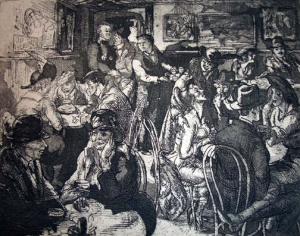Exactly ninety years ago, John Sloan, Marcel Duchamp, and four others climbed to the top of Washington Square Arch and proclaimed it the “free and independent republic of Washington Square.” That same year Sloan immortalized the Golden Swan saloon, better known as the Hell Hole or the Bucket of Blood, in an etching; shown here. Not only was the artist a frequent visitor to the saloon, but his studio was directly across the street and his 11th floor window looked down on the life-size, gilded swan that hung over the front door.
The artist described the scene in his diary, “The back room of Wallace’s … was a gathering place for artists, writers, and bohemians of Greenwich Village. The character in the upper right hand corner of the plate is Eugene O’Neill.”
The Wallace he refers to was Thomas Wallace, the proprietor of the bar and a former prizefighter. The figure in the back right is playwright Eugene O’Neill, who, as Sloan documents, was a regular to the Golden Swan. O’Neill also memorializes the bar by using it as the setting for his play The Iceman Cometh.
Today, the southeast corner of the intersection Fourth Street and Sixth Avenue has been transformed into a small park, known affectionately as the Golden Swan Park.
